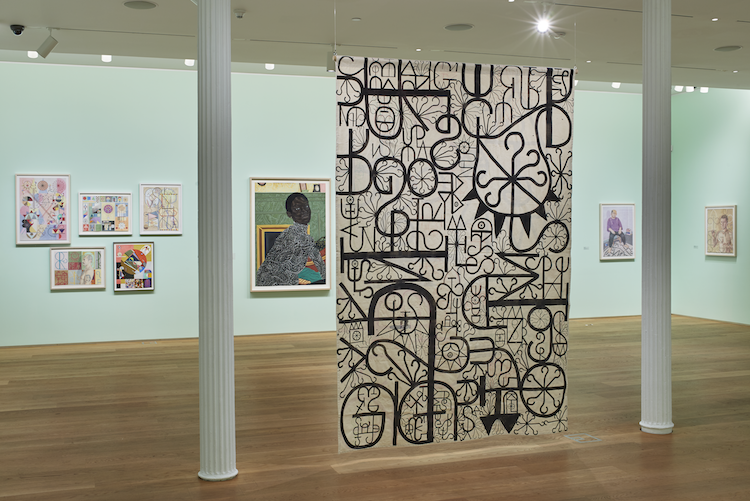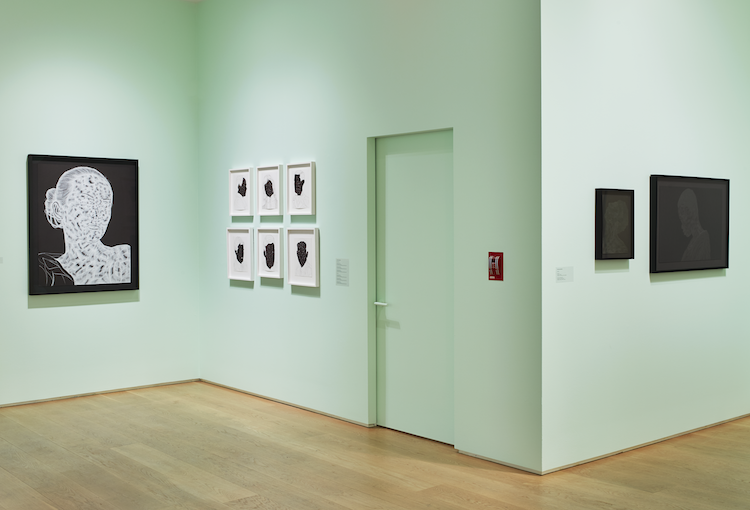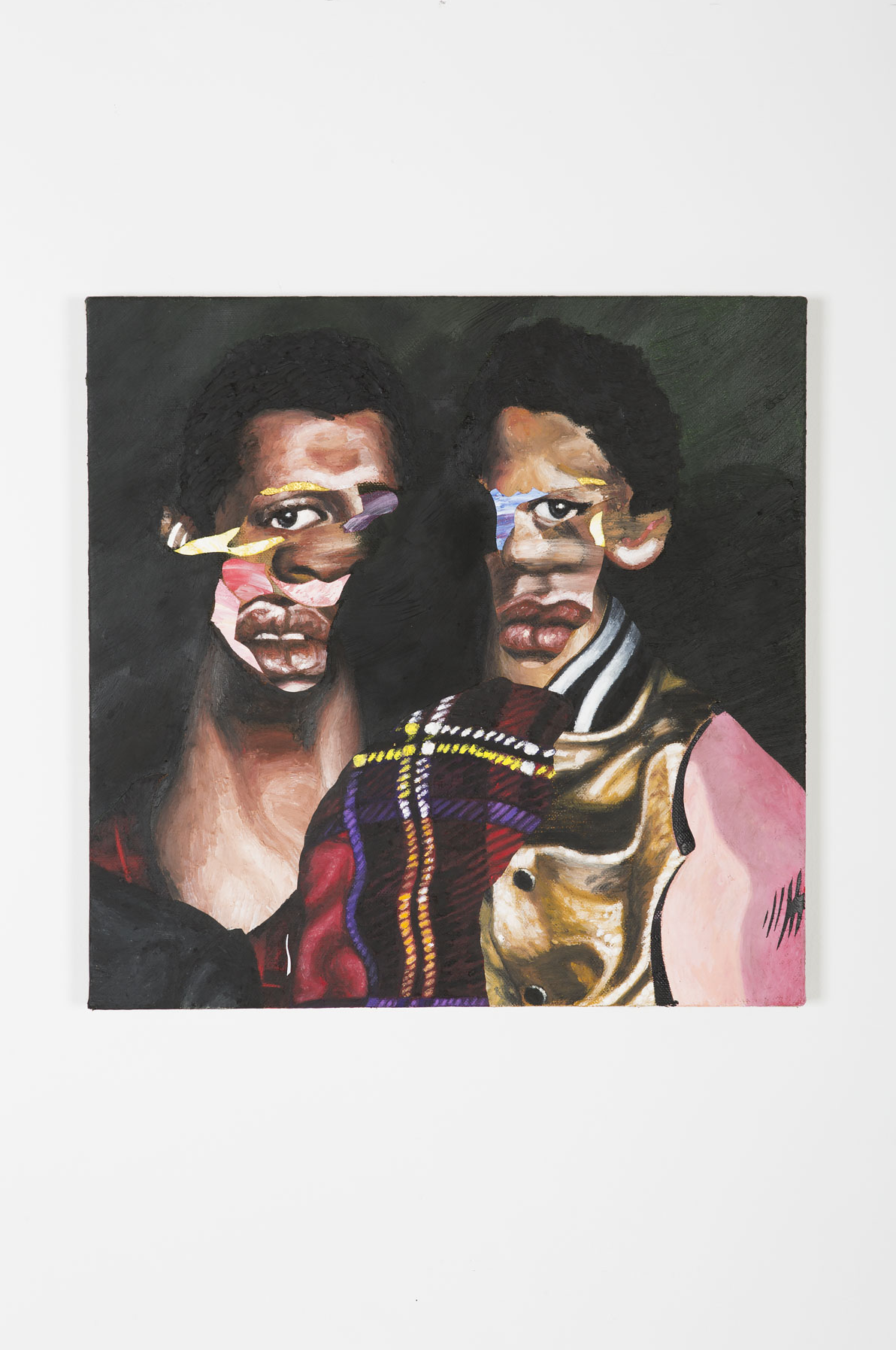For Opacity: Elijah Burgher, Toyin Ojih Odutola, and Nathaniel Mary Quinn, on view from October 12, 2018–February 3, 2019 in The Drawing Center’s Main Gallery, takes as its thesis the essay For Opacity by French-Martinican theorist Édouard Glissant. In the essay, Glissant presents “opacity” as the ability to exist without reduction by comparison: when opacity is applied, people are allowed to exist and be respected without being Othered or simplified by the dominant socio-cultural perspective. In the new publication Drawing Papers 138:For Opacity: Elijah Burgher, Toyin Ojih Odutola, and Nathaniel Mary Quinn, the contributing artists respond to Glissant through analysis of their own practices. In the excerpts below, each of these artists explores their relationships to the concept of opacity through magic, personal experience, or a bond with the subject of a portrait. To read more, check out the catalogue in print and on issuu.
Elijah Burgher: The Limits of Likeness
When I draw a particular person, I attempt to make a faithful representation, to capture a likeness. I find the latter expression funny—funny in the sense of warranting suspicion rather than causing amusement. The second listed definition of “capture” in the Oxford Dictionary is to “record accurately in words or pictures,” but the first one lends the aforementioned expression a foreboding undertone: to “take into one’s possession or control by force.”1 It’s as if, in capturing a likeness, one wrested a person’s appearance away from them, stripped a layer of it off them, perhaps robbed them of some of their power or essence. I’m reminded of the fear of photographic soul theft, as well as Sir James George Frazer’s first principle of sympathetic magic, the “Law of Similarity,” outlined in the Golden Bough: “Like produces like, or […] an effect resembles its cause,” whereby “the magician infers that he can produce any effect he desires merely by imitating it.”2 One could, accordingly, possess or control a person by making a forceful representation of them. As a teenager, I certainly made many drawings of boys, hoping I’d somehow induce them to fall in love with me by doing so.
In addition to these ominous powers imputed to mimesis, I think of the less obviously sinister platitude concerning an artist’s special skill at parting the veil of mere appearances and grasping the essence of a subject. Here’s where the essay by Édouard Glissant, “For Opacity,” comes in for me. He writes about the attempt to know the Other as a covert power struggle, a subtle form of subjugation.3 The Other—their difference, their essence—is a substance to be grasped, penetrated, and probed: “If we examine the process of ‘understanding’ people and ideas from the perspective of Western thought, we discover that its basis is this requirement for transparency.”4 The expression “to capture a likeness” might then disclose a fraught mode of relation between self and Other (in this case artist and model) in which a struggle for mastery is at play. Glissant is discussing a postcolonial situation, but the gist of his argument resonates strongly with other accounts of violence-wracked relationality, like the queer and feminist revisions of psychoanalysis by Leo Bersani and Kaja Silverman, both of whom have been crucial for me in terms of thinking about sexuality and what I do in the studio, especially with regard to figuration.
Continued on page 27 of Drawing Papers 138:For Opacity: Elijah Burgher, Toyin Ojih Odutola, and Nathaniel Mary Quinn

Installation view: For Opacity: Elijah Burgher, Toyin Ojih Odutola, and Nathaniel Mary Quinn, The Drawing Center, New York.October 12, 2018 – February 3, 2019. Photo: Martin Parsekian.
Toyin Ojih Odutola: Quotes
“Opacity is the right to not explain oneself, to not be pinned down. Not every drawing is an answer to a question. As James Baldwin wrote, ‘The purpose of art is to lay bare the questions that have been hidden by the answers.’”
—from a conversation with The Drawing Center Chief Curator Claire Gilman, May 23, 2018
“Drawing for me is investigative and I’m always investigating. The real subject is the exploration of the materials and the mark-making. Yes, there’s the ‘subject’ but what I’m really asking myself is what can I do to make the eye dance? When you look at the drawing from far away you may see something mundane but when you come up close, there’s this crazy array of mark-making especially on the skin. It has a lot to do with how we see people in the world. When we see someone and just let it settle, we are missing so much. If you can see the journey of the work, that’s when it’s beautiful.”
—from a conversation with The Drawing Center Chief Curator Claire Gilman, May 23, 2018
Continued on page 46 of Drawing Papers 138:For Opacity: Elijah Burgher, Toyin Ojih Odutola, and Nathaniel Mary Quinn

Installation view: For Opacity: Elijah Burgher, Toyin Ojih Odutola, and Nathaniel Mary Quinn, The Drawing Center, New York.October 12, 2018 – February 3, 2019. Photo: Martin Parsekian.
Nathaniel Mary Quinn: Preciate It, Unk and Opacity
Opacity as a means of addressing diversity permeates the ethereal atmosphere of my studio practice, the sustained exploration of the human spectrum, the removal of self-interpretation, and the rise of empathetic charges for enacting Relation, especially in the face of obscurity. Human behavior, quite naturally, is fractal; it is far more liberating to relinquish one’s pursuit of reducing behavior to the “obviousness of a transparency.”5 While my labor of love, discipline, and talent is interwoven within the texture of opacity, perhaps, for example, opacity is illuminated with a recent work, exhibited via Salon 94 Gallery, in 2018 for Frieze New York, entitled Preciate It, Unk! My work, wholly, is defined by multiplicity, the interweaving of parts, and the absence of hierarchy. The work’s aesthetic therefore is as opaque as the journey that gave rise to the work’s existence. Solidarity of Relation, between two young men and me, was beautifully shared; opacity was firmly embraced and accepted. Maybe some known or unknown entity inspired—perhaps against my will, or in step with some incessant need—a painting that reflects not the societal category of damnation by which my subjects have been conventionally (historically?) defined but rather the obscurity and unknowability of their humanity. Having a “grasp” of one another was not necessary for the establishment of Relation: opacity, in this case, allowed for the birth of somehow knowing that the moral barriers that one supposes to exist between oneself and the dangers outside are so tenuous as to be nearly nonexistent. They hugged me and asked if they could call me “Unk”—a term of endearment. The right to opacity was achieved.
Continued on page 72 of Drawing Papers 138:For Opacity: Elijah Burgher, Toyin Ojih Odutola, and Nathaniel Mary Quinn

Nathaniel Mary Quinn, Preciate it, Unk!, 2018. Oil paint, paint stick, oil pastel, gouache, acrylic, gold leaf on linen on wood panel, 20 x 20 inches. Courtesy of the artist and Salon 94, New York. (Work not on view in For Opacity)
To read more from all three artists, Édouard Glissant’s For Opacity, and Chief Curator Claire Gilman’s essay, check out Drawing Papers 138:For Opacity: Elijah Burgher, Toyin Ojih Odutola, and Nathaniel Mary Quinn in print and on issuu.
1. Angus Stevenson, ed. Oxford Dictionary of English, 3rd ed. (New York: Oxford University, 2010), s.v. “Capture.”
2. Sir James George Frazer, The Golden Bough: A Study in Magic and Religion, (New York: Palgrave Macmillan, 1990), 11.
3. Throughout Drawing Papers 138, the authors have capitalized key terms following the example set forth in Édouard Glissant, “For Opacity.”
4. Édouard Glissant, “For Opacity,” in Poetics of Relation, trans. Betsy Wing (Ann Arbor, MI: University of Michigan Press, 1997), 189–90. Originally published as Poétique de la relation (Paris: Gallimard, 1990).
5. Ibid., 193.
